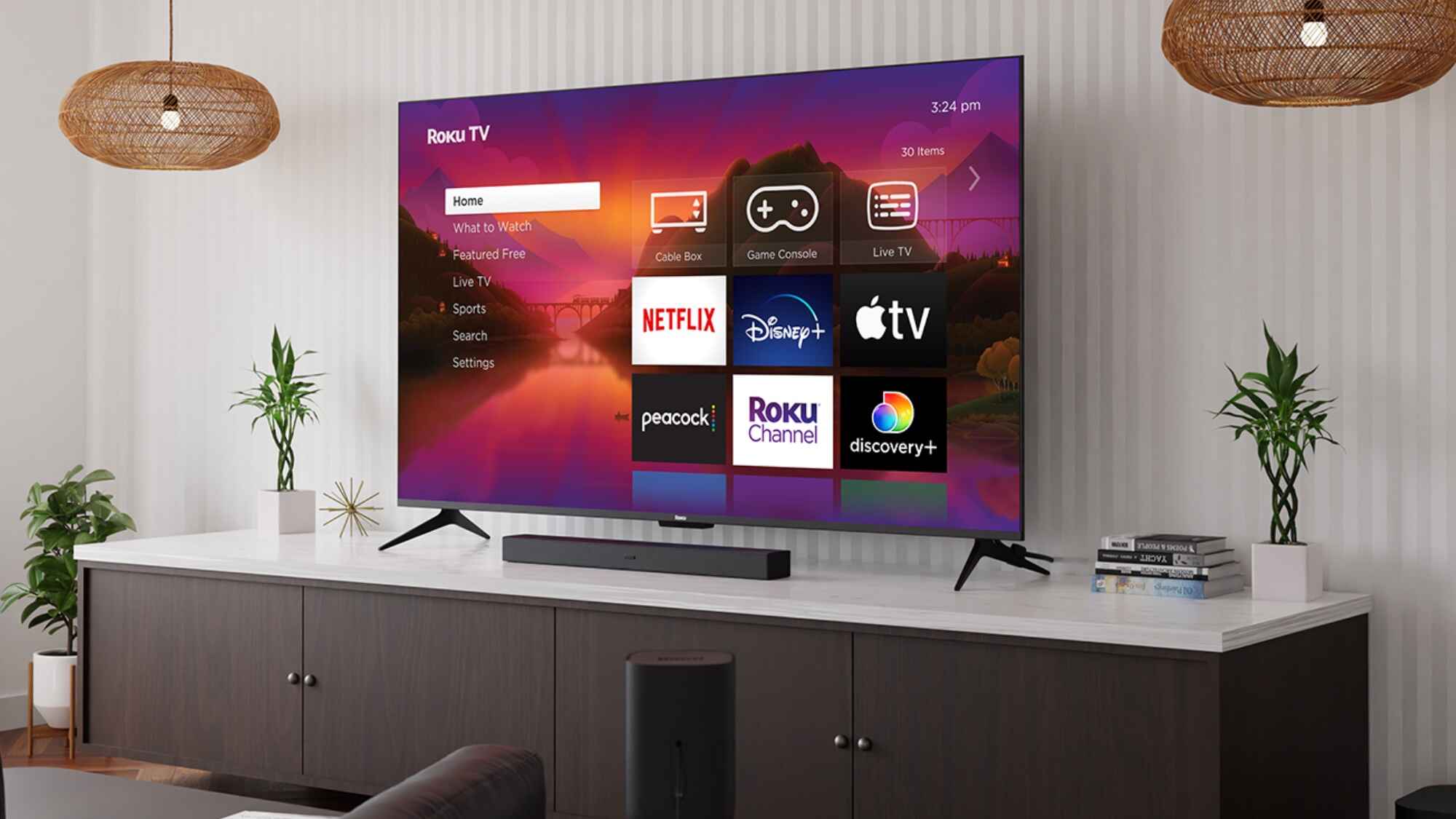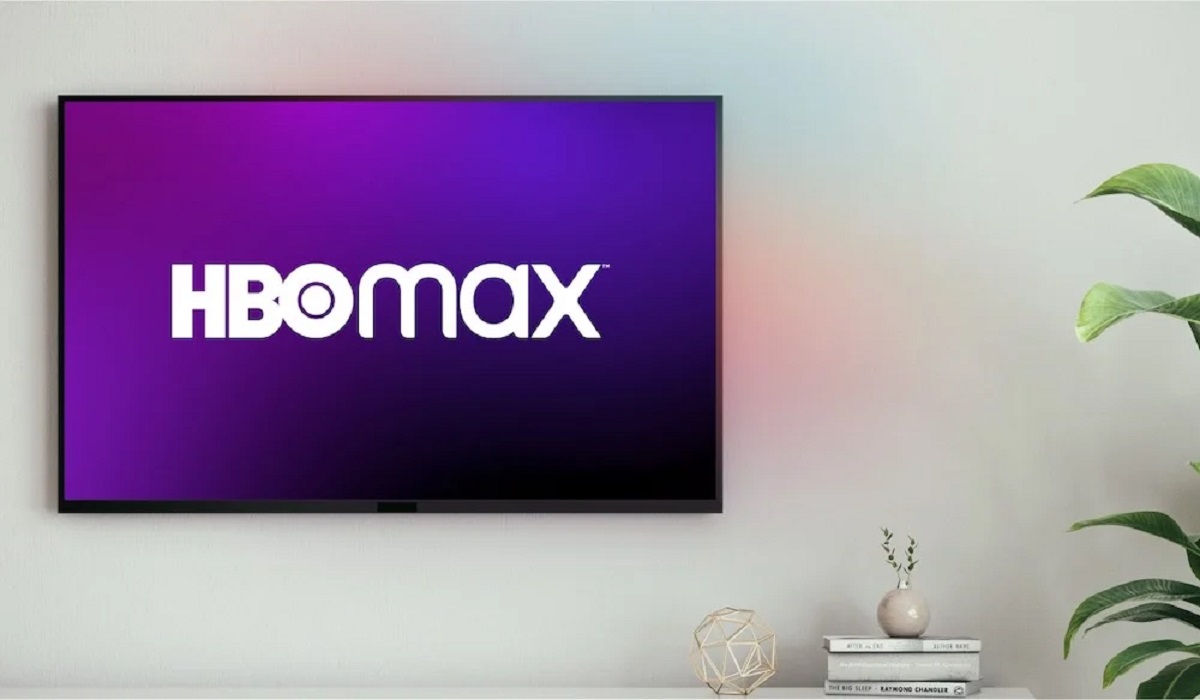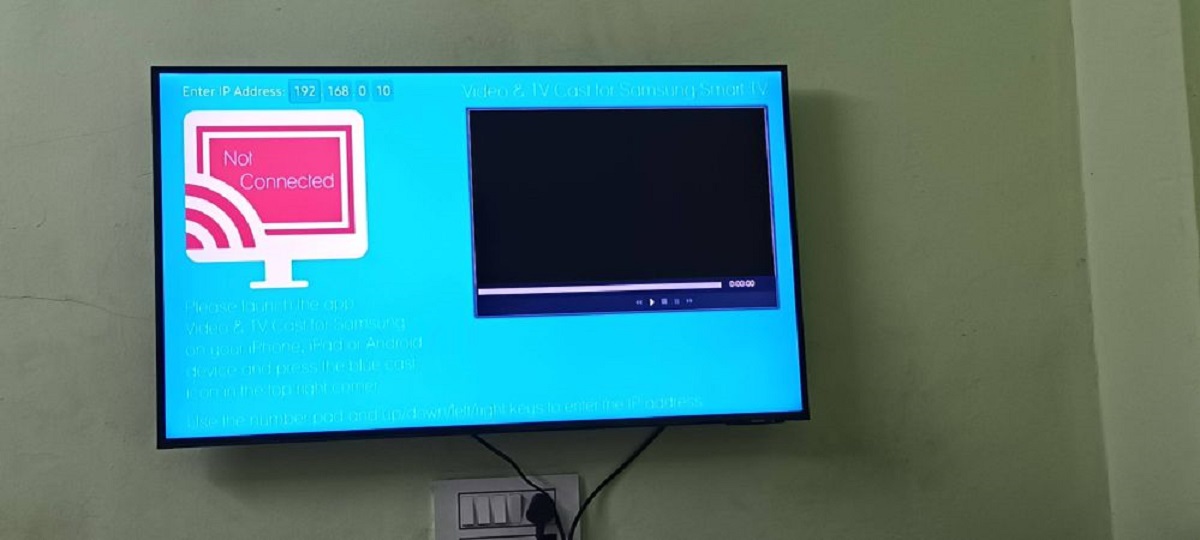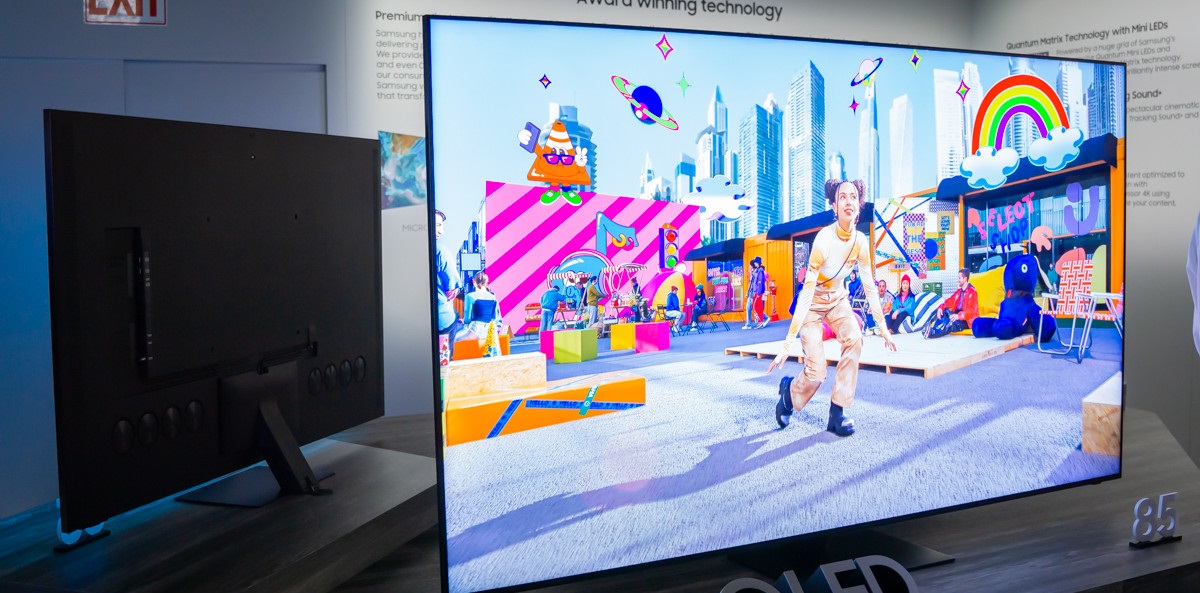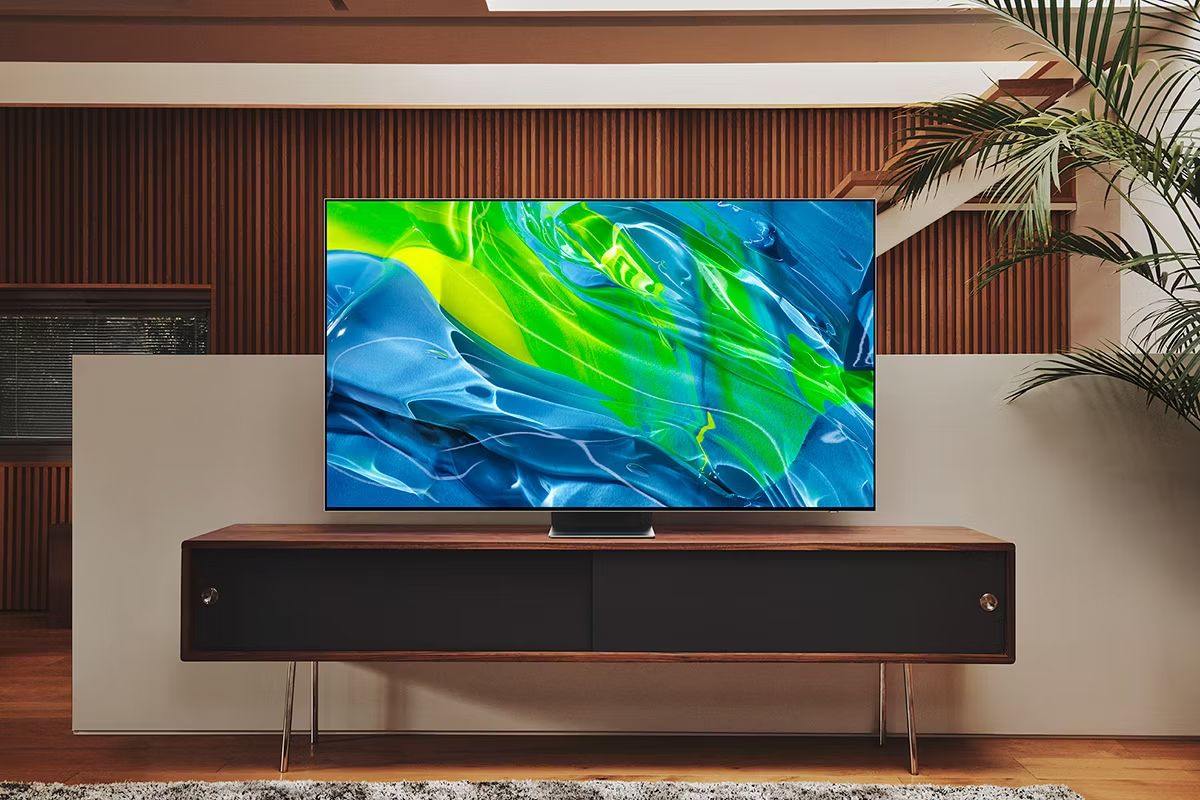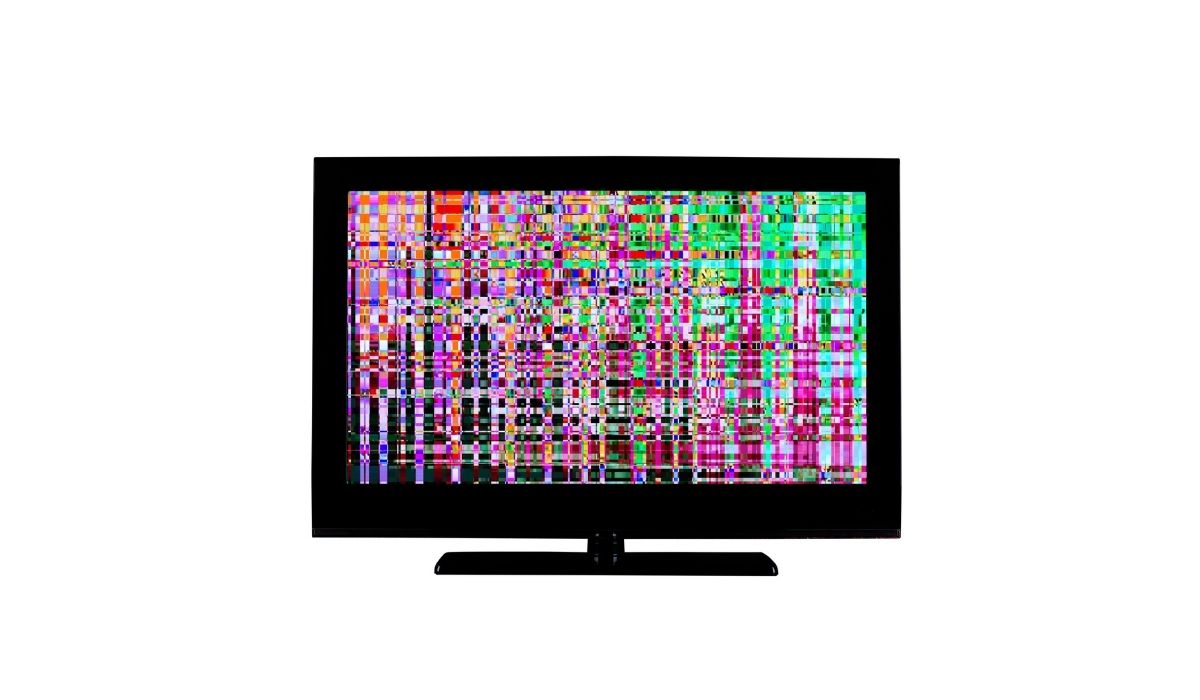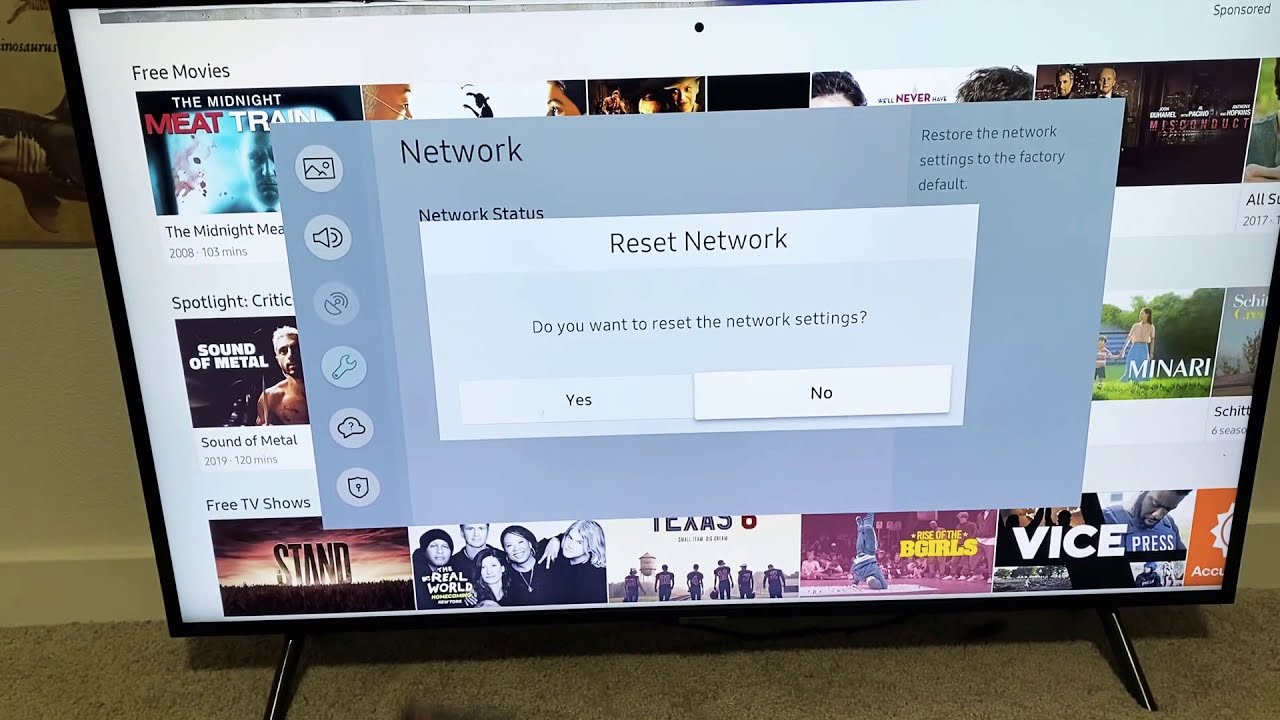Introduction
Buffering is a common frustration that many Samsung Smart TV owners experience while trying to enjoy their favorite shows and movies. It can be incredibly annoying as it disrupts the smooth flow of content and interrupts the viewing experience. But what causes buffering in Samsung Smart TVs in the first place? And more importantly, how can it be fixed?
Buffering occurs when there is a delay in streaming media content. It happens when your Smart TV is unable to receive a steady and continuous stream of data from the internet. Instead, it has to pause and store (“buffer”) a certain amount of content before it can play it back smoothly on the screen.
There are several factors that can contribute to buffering issues on Samsung Smart TVs. One of the most common causes is insufficient internet speed. If your internet connection is slow or unstable, your Smart TV won’t be able to receive the data it needs to stream content seamlessly. Network connectivity issues can also lead to buffering problems, as a weak or unstable Wi-Fi signal can result in interruptions in the data flow.
In some cases, outdated firmware can also be the culprit. Just like other electronic devices, your Smart TV’s software needs to be regularly updated to ensure optimal performance. Outdated firmware may not be able to handle the latest streaming protocols, leading to buffering issues.
Additionally, overloaded streaming apps can cause buffering problems. If there are too many applications running in the background or if the app you are using is experiencing high traffic, it may struggle to keep up with the demand, resulting in buffering.
In the following sections, we will explore these causes in more detail and provide practical solutions to help fix buffering issues on your Samsung Smart TV. By following these steps, you can enjoy uninterrupted entertainment without the frustration of constant buffering interruptions.
What Causes Buffering in Samsung Smart TVs?
Buffering in Samsung Smart TVs can be caused by a variety of factors. Understanding these causes is essential in finding the right solutions to fix buffering issues. Let’s take a closer look at the main culprits:
Insufficient Internet Speed: One of the most common causes of buffering is having a slow internet connection. Streaming high-quality content requires a stable and fast internet speed. If your internet plan is not capable of providing sufficient bandwidth, your Smart TV may struggle to receive the data it needs, resulting in buffering.
Network Connectivity Issues: Weak or unstable Wi-Fi signals can contribute to buffering problems. Distance from the router, interference from other devices, or congestion on your Wi-Fi network can affect the strength of your connection. This can lead to interruptions in the data flow, causing buffering while streaming content.
Outdated Firmware: Firmware acts as the software that runs your Samsung Smart TV, and just like any other software, it needs to be updated regularly. Outdated firmware may lack the necessary optimizations and compatibility with the latest streaming protocols. This can result in buffering issues, as your Smart TV may struggle to handle the demands of streaming media.
Overloaded Streaming Apps: If you have multiple streaming apps running simultaneously or if the app you are using is experiencing heavy traffic, it can overload your Smart TV’s resources. This can lead to buffering as your device struggles to keep up with the data demand.
Insufficient Memory: Samsung Smart TVs have a limited amount of available memory. If you have too many apps or processes running in the background, it can consume the available memory and slow down your Smart TV’s performance. This can contribute to buffering as your TV may not have enough resources to handle data efficiently.
To overcome buffering issues, it is important to identify the underlying cause. By addressing these factors, you can optimize your internet connection, update your firmware, manage your apps, and ensure your Smart TV has ample memory. In the following sections, we will delve into specific solutions to help resolve buffering issues on your Samsung Smart TV.
Insufficient Internet Speed
One of the primary causes of buffering on Samsung Smart TVs is having insufficient internet speed. When streaming content, the Smart TV needs a consistent and fast internet connection to receive data seamlessly. If your internet speed is slow or not capable of handling the demands of streaming, buffering issues may occur.
Internet speed is measured in Mbps (megabits per second). The faster your internet speed, the more efficiently your Smart TV can download and display content. To determine if your internet speed is the cause of buffering, you can perform a speed test using online tools or dedicated speed test apps.
So, what is considered an ideal internet speed for streaming without buffering? The recommended speed can vary depending on the quality of the content you’re streaming. For example, streaming standard definition (SD) content generally requires a minimum speed of 3 Mbps, while high-definition (HD) content may require 5 Mbps or higher. If you’re streaming 4K Ultra HD content, you’ll need even faster speeds, with recommendations ranging from 15-25 Mbps.
If your speed test results indicate that your internet speed is not meeting the recommended requirements for the type of content you’re streaming, you can take several steps to improve your speed:
- Upgrade Your Internet Plan: Contact your Internet Service Provider (ISP) and inquire about upgrading your plan to a higher speed tier. This may involve a higher monthly cost, but it can significantly improve your streaming experience by providing faster and more stable internet speeds.
- Connect to Wired Connection: Wi-Fi signals can be susceptible to interference and limitations due to distance. Consider connecting your Smart TV directly to your router using an Ethernet cable for a more reliable and faster connection.
- Optimize Wi-Fi Signal: If using Wi-Fi is your only option, there are steps you can take to optimize your connection. Position your router in a central location, away from obstructions, and avoid placing it near other wireless devices that can cause interference. You can also try changing the Wi-Fi channel on your router to reduce congestion and improve signal strength.
- Limit Bandwidth Usage: If other devices on your network are consuming bandwidth, it can affect your Smart TV’s streaming performance. Consider limiting or temporarily pausing downloads, uploads, or any bandwidth-consuming activities while streaming to ensure your Smart TV receives an adequate share of bandwidth.
- Consider QoS Settings: Quality of Service (QoS) settings on your router can prioritize certain types of internet traffic, such as streaming, over others. Check your router’s settings to see if you can enable QoS and prioritize streaming traffic for a smoother streaming experience.
By addressing and improving your internet speed, you can minimize buffering issues and enjoy uninterrupted streaming on your Samsung Smart TV.
Network Connectivity Issues
Another common cause of buffering on Samsung Smart TVs is network connectivity issues. Weak or unstable Wi-Fi signals can disrupt the flow of data between your Smart TV and the internet, resulting in buffering during streaming sessions. Understanding and resolving these connectivity issues can help improve your streaming experience.
There are several factors that can contribute to network connectivity issues:
- Distance from the Router: The distance between your Samsung Smart TV and your wireless router can impact the strength of the Wi-Fi signal. The farther away your TV is from the router, the weaker the signal may become. If possible, try to position your Smart TV closer to the router to improve the signal strength and reduce buffering.
- Obstructions and Interference: Walls, furniture, and other physical obstructions can weaken the Wi-Fi signal. Additionally, neighboring networks or devices can cause interference, further degrading the signal quality. Try to minimize physical obstructions and locate your router away from other electronic devices to reduce interference and improve Wi-Fi performance.
- Router Placement: The placement of your wireless router plays a crucial role in signal strength and coverage. Positioning the router in a central location within your home can help ensure better coverage across different rooms. Elevating the router to a higher position, such as on a shelf, can also improve signal propagation.
- Channel Congestion: If you live in a densely populated area or an apartment complex, there may be multiple Wi-Fi networks operating on the same channel as yours. This congestion can cause interference and lead to connectivity issues. Log in to your router’s settings and change the Wi-Fi channel to one with less congestion to improve network performance.
Here are some steps you can take to resolve network connectivity issues:
- Perform a Wi-Fi Signal Test: Use a smartphone or a laptop to test the Wi-Fi signal strength near your Smart TV. This can help identify weak signal areas in your home where buffering is more likely to occur. Consider repositioning your router or installing Wi-Fi range extenders to cover those areas.
- Use a Wi-Fi Analyzer: Wi-Fi analyzer apps can help you identify the best Wi-Fi channel to use. They can detect nearby networks and their channel usage, allowing you to make an informed decision to select a less congested channel for your router.
- Upgrade Your Router: Older routers may not be capable of delivering optimal Wi-Fi performance. Consider upgrading to a newer, more powerful router that supports the latest Wi-Fi standards, such as Wi-Fi 5 (802.11ac) or Wi-Fi 6 (802.11ax), for better coverage and faster speeds.
- Mesh Wi-Fi System: If you consistently experience weak signals in certain areas of your home, consider using a mesh Wi-Fi system. Mesh systems consist of multiple units that work together to provide seamless Wi-Fi coverage throughout your home, eliminating dead zones and improving connectivity.
- Restart Your Router: Sometimes, a simple router restart can resolve temporary connectivity issues. Unplug your router from the power source, wait for a minute, and then plug it back in. This can clear any minor issues and provide a fresh start for your network.
By addressing network connectivity issues, you can improve the stability and quality of your Wi-Fi signal, reducing buffering on your Samsung Smart TV and enhancing your streaming experience.
Outdated Firmware
Outdated firmware can contribute to buffering issues on Samsung Smart TVs. Firmware acts as the software that controls the functionality of your Smart TV, including its ability to handle streaming media. If your Smart TV’s firmware is outdated, it may not have the necessary optimizations or compatibility with the latest streaming protocols, resulting in buffering problems.
Updating the firmware of your Samsung Smart TV is essential to ensure optimal performance and compatibility with the latest streaming technologies. Here’s how you can check and update your firmware:
- Check for Updates: Go to the Settings menu on your Samsung Smart TV and navigate to the “Support” or “System” section. Look for an option such as “Software Update” or “Firmware Update.” Select it to check for any available updates.
- Automatic Updates: Some Smart TVs have the option to enable automatic firmware updates. If available, enable this feature to ensure your Smart TV stays up to date without manual intervention. Automatic updates can provide a hassle-free way to keep your firmware current.
- Download and Install Updates: If there are available firmware updates, follow the prompts to download and install them. Make sure your Smart TV is connected to the internet during this process. The TV may restart once the firmware update is completed.
- USB Firmware Update: In some cases, you may need to manually update the firmware using a USB drive. Visit the official Samsung support website and search for your TV model to find the appropriate firmware file. Download the firmware file to a USB drive and insert it into the USB port of your Smart TV. Follow the on-screen instructions to update the firmware.
It is essential to follow the instructions provided by Samsung or consult the official support documentation for your specific Smart TV model when updating the firmware. Following the correct procedure ensures a successful update and reduces the risk of any potential issues.
Regularly updating your Smart TV’s firmware not only addresses buffering issues but also ensures that your device remains secure and benefits from any performance or feature improvements. Set a reminder to periodically check for firmware updates and keep your Samsung Smart TV up to date.
By keeping your Smart TV’s firmware current, you can maximize its performance and compatibility, reducing buffering and enhancing your streaming experience.
Overloaded Streaming Apps
Overloaded streaming apps can also contribute to buffering issues on Samsung Smart TVs. When multiple apps are running simultaneously or when the app you’re using experiences high traffic, it can put a strain on your Smart TV’s resources, leading to buffering and interruptions in the streaming experience.
To address overloaded streaming apps and minimize buffering, you can take the following steps:
- Close Background Apps: When you’re finished with a streaming app, make sure to exit or close it properly. Running multiple apps in the background can consume system resources and impact the performance of your Smart TV. By closing unnecessary apps, you free up resources for smooth streaming.
- Update Streaming Apps: Just like firmware updates for your Smart TV, it’s crucial to keep your streaming apps up to date. App developers frequently release updates that can improve performance, fix bugs, and optimize streaming capabilities. Check for app updates in the app store of your Samsung Smart TV and install them regularly.
- Clear App Cache and Data: Over time, streaming apps can accumulate unnecessary data and cache, which can affect their performance. Clearing the cache and data of your streaming apps can help resolve buffering issues. To do this, go to the Settings menu of your Smart TV, navigate to the “Apps” or “Application Manager” section, find the streaming app, and select the option to clear cache and data.
- Uninstall Unnecessary Apps: If you have a multitude of streaming apps installed on your Smart TV, consider uninstalling the ones you no longer use. This can free up storage space and improve the overall performance of your device, allowing the remaining apps to run more smoothly.
- Limit Concurrent Streams: Some streaming platforms limit the number of devices that can stream content simultaneously on a single account. If you have multiple devices streaming at the same time, it can strain your internet connection and lead to buffering issues. Check the account settings of your streaming apps and adjust the number of concurrent streams to a manageable level.
By managing and optimizing the performance of the streaming apps on your Samsung Smart TV, you can reduce buffering and enjoy uninterrupted streaming. Keep your apps up to date, clear cache and data regularly, and limit background processes to ensure a smooth and seamless streaming experience.
How to Fix Buffering Issues
If you’re experiencing buffering issues on your Samsung Smart TV, there are several steps you can take to troubleshoot and resolve the problem. By following these solutions, you can enjoy uninterrupted streaming and eliminate the frustration of constant buffering interruptions.
Here’s how you can fix buffering issues on your Samsung Smart TV:
- Check your Internet Connection: Ensure that your internet connection is stable and capable of handling the streaming demands. Perform a speed test to check your internet speed and compare it to the recommended requirements for the content you’re streaming. If your speed falls short, consider upgrading your internet plan or optimizing your Wi-Fi connection.
- Restart your Router and Smart TV: Sometimes a simple reset can solve buffering problems. Start by turning off your Smart TV and unplugging the power cord from the router. Wait for a couple of minutes, then plug the router back in, followed by turning on your Smart TV. This can refresh the network connection and potentially resolve any temporary issues.
- Update your Smart TV’s Firmware: Outdated firmware can contribute to buffering issues. Check for any available firmware updates in the settings menu of your Samsung Smart TV. By keeping your Smart TV’s firmware up to date, you ensure optimal performance and compatibility with the latest streaming protocols.
- Clear Cache and Data of Streaming Apps: Over time, streaming apps can accumulate unnecessary data and cache, impacting their performance. Clear the cache and data of your streaming apps to free up storage space and enhance their efficiency. This can usually be done in the settings or applications menu of your Smart TV.
- Avoid Overloading Your Network: Too many devices using the same internet connection or bandwidth-intensive activities can strain your network, leading to buffering. Limit the number of devices streaming simultaneously and avoid performing other bandwidth-heavy tasks while streaming to ensure a smooth experience.
Implementing these solutions can help resolve buffering issues on your Samsung Smart TV. However, it’s important to note that buffering can also be influenced by external factors, such as the quality and stability of the streaming service itself. If the buffering issue persists, it may be worth contacting the streaming service provider for further assistance.
By optimizing your internet connection, keeping your firmware up to date, managing streaming apps, and avoiding network overload, you can significantly improve your Samsung Smart TV’s streaming performance and enjoy uninterrupted entertainment.
Check your Internet Connection
When experiencing buffering issues on your Samsung Smart TV, the first step is to check the status of your internet connection. Buffering often occurs due to a slow or unstable internet connection, which hampers the smooth streaming of content. By evaluating your internet connection, you can determine if it is the root cause of the buffering problem and take appropriate steps to resolve it.
Performing an internet speed test is a practical way to assess the speed and stability of your connection. There are numerous online tools and dedicated speed test apps available that can provide accurate results. The speed test will measure your download and upload speeds, latency, and sometimes packet loss, which may affect your streaming experience.
Compare your internet speed to the recommended requirements for streaming content. Different streaming qualities have different speed recommendations, such as SD (Standard Definition), HD (High Definition), and Ultra HD or 4K. For example, SD streaming generally requires a minimum download speed of around 3 Mbps, while 4K streaming may demand speeds of 15 Mbps or higher.
If your internet speed falls significantly below the recommended requirements for your desired streaming quality, there are several steps you can take to improve it:
- Upgrade your internet plan: Contact your Internet Service Provider (ISP) and inquire about faster internet speed options. Upgrading to a higher speed plan can provide a more stable and reliable connection, reducing buffering issues during streaming.
- Connect via Ethernet: If possible, consider connecting your Samsung Smart TV directly to your router using an Ethernet cable. Wired connections tend to be more stable and faster than wireless connections, resulting in smoother streaming experiences.
- Optimize your Wi-Fi: If wireless connectivity is your only option, make sure your Smart TV is within range of your Wi-Fi router. Position the router in a central location, free from obstructions, and away from potential sources of interference, such as other electronic devices or thick walls. Additionally, check that your router firmware is up to date.
- Reduce network congestion: If multiple devices are simultaneously using your internet connection, it can lead to network congestion and buffering. Limit the number of devices actively using the network, especially during streaming sessions, to ensure more bandwidth is available for your Smart TV.
- Restart your modem and router: Sometimes, a simple power cycle of your modem and router can resolve temporary internet connection issues. Unplug the power cords, wait for around 30 seconds, then plug them back in and allow them to reboot.
By evaluating and improving your internet connection, you can significantly reduce buffering issues and enjoy uninterrupted streaming on your Samsung Smart TV. However, if buffering persists even after optimizing your connection, it may be worth contacting your ISP for further assistance.
Restart your Router and Smart TV
Restarting your router and Smart TV is a simple yet effective troubleshooting step that can help resolve buffering issues on your Samsung Smart TV. As electronic devices, both the router and Smart TV can encounter temporary glitches or issues that can affect their performance. Restarting these devices can refresh their system and potentially resolve any underlying problems.
Here’s how you can restart your router and Smart TV:
- Router: Begin by locating your wireless router and identifying the power source. Unplug the power cord from the router and wait for about 30 seconds. This waiting period allows any residual power to dissipate and provides a clean start when the router is powered back on.
- Smart TV: Next, navigate to the menu settings of your Samsung Smart TV using the remote control. Find the power options and choose to turn off your Smart TV. Once the TV is off, disconnect the power cord from the wall socket or power strip.
- Wait: Allow a few moments for both the router and Smart TV to remain unplugged. During this time, any temporary network issues or software glitches may dissipate.
- Reconnect: After waiting for the allocated time, plug the power cord back into the router and wait for it to fully power up. Once the router is online, connect your Smart TV directly to the power source and turn it on.
- Network Connection: Once your Smart TV has powered on, reconnect it to your home network. Navigate to the network settings on your TV and select your Wi-Fi network. Enter the password if prompted and establish a connection.
Restarting both your router and Smart TV can help resolve any temporary issues that may be causing buffering problems. It allows the devices to start fresh, reestablish their network connections, and clear any temporary software or connectivity glitches.
It’s important to note that while restarting may fix common connectivity issues, it may not address underlying network problems or issues related to internet service providers. If buffering issues persist even after restarting your router and Smart TV, additional troubleshooting steps may be necessary. These may include checking your internet connection, updating firmware, or adjusting streaming settings on your Smart TV.
By applying this simple restart step, you can often resolve buffering issues and regain a smooth streaming experience on your Samsung Smart TV.
Update your Smart TV’s Firmware
Keeping your Samsung Smart TV’s firmware up to date is crucial in resolving buffering issues and ensuring optimal performance. Firmware acts as the software that controls the functionality of your Smart TV, including its ability to handle streaming media. Outdated firmware may lack necessary optimizations or compatibility with the latest streaming protocols, leading to buffering problems.
Here’s how you can update your Smart TV’s firmware:
- Check for Updates: Start by accessing the settings menu on your Samsung Smart TV. The location of the settings menu may vary depending on the model, but it is typically accessible through the remote control. Look for an option such as “Support,” “System,” or “Settings & Support.”
- Software Update: Within the settings menu, locate the “Software Update” or “Firmware Update” option. Select it to check for any available updates for your Smart TV’s firmware. The TV will then search for updates online.
- Automatic Updates: Some Smart TVs offer the option to enable automatic firmware updates. If available, consider enabling this feature. With automatic updates, your Smart TV will check for and install firmware updates in the background, ensuring that it remains up to date without manual intervention.
- Download and Install: If your Smart TV detects an available firmware update, follow the on-screen prompts to begin the download and installation process. Make sure your Smart TV is connected to the internet during this process, as it requires a stable connection to download the update files.
- Wait and Restart: Once the firmware update is completed, your Smart TV may require a restart. Some Smart TVs restart automatically, while others may prompt you to initiate the restart manually. Follow the instructions provided by your Smart TV to complete the firmware update process.
It is important to note that the process of updating firmware may vary slightly depending on your Samsung Smart TV model. If you encounter any difficulties or require detailed instructions specific to your TV’s firmware update process, consult the official Samsung website or user manual for guidance.
By keeping your Smart TV’s firmware up to date, you ensure that it has the latest optimizations and compatibility with streaming protocols. This helps in minimizing buffering issues and ensuring that your Smart TV runs smoothly during streaming sessions.
Set a reminder to periodically check for firmware updates for your Samsung Smart TV. Regular firmware updates not only address buffering issues but also provide crucial security updates, bug fixes, and additional features, enhancing your overall viewing experience.
Clear Cache and Data of Streaming Apps
Clearing the cache and data of streaming apps on your Samsung Smart TV is an effective way to resolve buffering issues. Over time, streaming apps accumulate temporary files and data, which can impact their performance and lead to buffering during playback. By clearing the cache and data of these apps, you can free up storage space and improve their efficiency.
Here’s how you can clear the cache and data of streaming apps on your Samsung Smart TV:
- Access App Settings: Using your Smart TV remote, go to the home screen and navigate to the app drawer or the screen where your streaming apps are located.
- Select the App: Locate the specific streaming app that you want to clear the cache and data for. Use the arrow keys on your remote to highlight the app and press the “OK” button to select it.
- Open App Settings: Once you have selected the app, look for the Settings or Options menu within the app interface. The exact location of the settings menu can vary depending on the app. It is usually represented by an icon with three vertical dots or as an entry in the app’s main menu.
- Clear Cache: Within the app settings, you should see an option to clear the cache. Select this option to delete temporary files and data associated with the app. This action will not remove any personal data or settings related to your account or preferences.
- Clear Data: If available, you may also have the option to clear the app’s data. This action will reset the app to its default settings and remove any personalization or customization you have made. Only choose this option if clearing the cache alone does not resolve the buffering issues.
- Confirm the Action: After selecting the clear cache or clear data option, a confirmation message may appear on the screen. Confirm your selection to proceed with clearing the cache or data.
- Repeat for Other Apps: If you experience buffering issues with multiple streaming apps, repeat the above steps for each app individually, clearing the cache and data as necessary.
Clearing the cache and data of streaming apps helps remove temporary files and data that may be causing performance issues. By doing so, you create a clean slate for the apps to operate more efficiently, potentially resulting in smoother streaming experiences on your Samsung Smart TV.
It’s important to note that clearing the cache and data of an app will reset it to its default state. Any settings, login credentials, or personalized preferences will be lost. However, you can easily reconfigure the app after clearing the cache and data.
Consider incorporating regular cache clearing as a part of your Smart TV maintenance routine to keep the apps running smoothly and prevent buffering issues from recurring.
Avoid Overloading Your Network
Overloading your network can lead to buffering issues on your Samsung Smart TV. When multiple devices are using the same internet connection simultaneously or performing bandwidth-intensive activities, such as downloading large files or online gaming, it can strain the network and result in buffering during streaming sessions. By managing your network traffic and minimizing excessive demands on bandwidth, you can create a smoother streaming experience on your Smart TV.
Here are some steps to avoid overloading your network:
- Limit Concurrent Streams: Most streaming platforms allow multiple devices to stream content simultaneously using a single account. If you have multiple devices streaming at once, it can consume a significant portion of your available bandwidth and potentially cause buffering. Consider limiting the number of devices that are simultaneously streaming to reduce the strain on your network.
- Pause Background Downloads and Updates: Downloads and updates running in the background on other devices can consume a considerable amount of bandwidth. Pause or temporarily halt any ongoing downloads, updates, or other bandwidth-heavy activities while streaming on your Smart TV to ensure more bandwidth is dedicated to streaming media.
- Manage Bandwidth-Quality Settings: Some streaming services allow you to adjust the quality of the content being streamed. Higher-quality streaming requires more bandwidth. If you are experiencing buffering issues, consider reducing the streaming quality to a lower setting, such as from 4K to HD or SD. This reduces the amount of data being transmitted, easing the demand on your network.
- Use Quality of Service (QoS) Settings: Many modern routers have Quality of Service (QoS) settings that allow you to prioritize specific types of internet traffic. Enable QoS on your router and prioritize streaming traffic to ensure a smoother streaming experience, especially during times when network activity is high.
- Upgrade your Internet Plan: If you consistently encounter buffering issues due to network overload, it may be worth considering upgrading your internet plan. Contact your Internet Service Provider (ISP) to explore higher-speed internet options that can better accommodate multiple devices streaming simultaneously.
By implementing these strategies, you can effectively manage your network and reduce the risk of buffering caused by overloading. The goal is to ensure that your Smart TV receives an adequate share of the available bandwidth for seamless streaming without interruptions.
It’s important to note that network overload can occasionally occur due to external factors, such as peak usage times in your area or issues with your internet service provider. If buffering issues persist despite implementing these recommendations, you may want to reach out to your ISP for further assistance.
Conclusion
Buffering issues can be frustrating when you’re trying to enjoy your favorite shows and movies on your Samsung Smart TV. However, by understanding the causes and implementing the appropriate solutions, you can significantly reduce or eliminate buffering problems and enhance your streaming experience.
We explored several common causes of buffering, including insufficient internet speed, network connectivity issues, outdated firmware, and overloaded streaming apps. These factors can contribute to buffering on your Smart TV and disrupt the smooth playback of media content.
To address buffering issues, it’s important to check your internet connection and ensure it meets the recommended speed requirements for the content you’re streaming. Upgrading your internet plan or optimizing your Wi-Fi connection can help improve your internet speed and stability.
In addition, resolving network connectivity issues, such as positioning your Smart TV closer to the router or reducing interference, can enhance the quality of your Wi-Fi signal and reduce buffering. Keeping your Smart TV’s firmware up to date is crucial, as outdated firmware may not be able to handle the demands of streaming media, leading to buffering problems.
Clearing the cache and data of streaming apps and managing network congestion by limiting concurrent streams and pausing background downloads can also minimize buffering issues. By avoiding overloading your network and ensuring that your Smart TV has sufficient bandwidth, you can create a smoother streaming experience.
Remember, troubleshooting buffering problems requires a combination of these solutions and may require trial and error to find the optimal settings and adjustments for your specific setup. Additionally, it’s important to keep an eye out for firmware updates and perform routine maintenance tasks to keep your Smart TV running smoothly.
By following these steps and implementing the recommended solutions, you can enjoy uninterrupted streaming and make the most of your Samsung Smart TV’s capabilities, without the annoyance of buffering interruptions.







